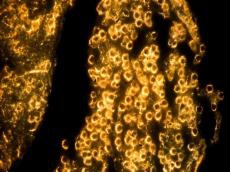|
|
TODAY.AZ / World news
Scientists create gold foil with thickness of one atom
17 April 2024 [21:20] - TODAY.AZ

For the first time, Swedish scientists from the University of Linkoping managed to create a two—dimensional form of gold - a film with a thickness of one atom. The new material was named golden by analogy with graphene, which is a two-dimensional layer of carbon, Azernews reports, citing foreign media outlets.
The study was published in the scientific journal Nature Synthesis (NatSynt). Gold is quite difficult to transform into a two-dimensional form due to its properties. Previous attempts had resulted in either a sheet several atoms thick or a monolayer that could not be separated from other materials.
After several years of experimentation, the researchers found a solution based on an etching solution called Murakami reagent. It is a mixture of chemicals used in metalworking to etch carbon and stain steel. In Japan, it is used to create special patterns on knife blades.
With the help of a reagent, specialists managed to dissolve titanium and carbon, with which gold was given a monoform. The reaction took place in complete darkness, because when exposed to light, potassium ferrocyanide appeared in the solution, which dissolved the gold.
Ordinary gold serves as a good conductor of electricity. In two-dimensional form, the metal acquires the properties of a semiconductor, the conductivity of which can be adjusted. This will allow the use of golden for water purification and in the chemical industry, the researchers noted.
URL: http://www.today.az/news/regions/247270.html
 Print version
Print version
Connect with us. Get latest news and updates.
See Also
- 16 November 2024 [19:25]
Vienna's solar balcony stations booming thanks to falling prices - 16 November 2024 [08:00]
US and Britain extended treaty on use of atomic energy for defense purposes - 15 November 2024 [23:30]
United States deploys naval reconnaissance aircraft in Scotland - 15 November 2024 [22:27]
Schumacher's latest car is up for auction - 15 November 2024 [21:46]
Tbilisi City Hall allocated 8.6 million lari for New Year's events - 15 November 2024 [20:48]
Iran prepares to treat women who violate hijab law - 14 November 2024 [23:45]
Minister Bayraktar emphasizes Turkiye's role in net zero emissions - 14 November 2024 [23:26]
Poland deployed South Korean K2 tanks near border with Russia - 14 November 2024 [22:50]
Pentagon spent $1 billion on the US military industry - 14 November 2024 [21:40]
US budget deficit quadrupled in year
Most Popular
 Provocateur Le Pen go to jail
Provocateur Le Pen go to jail
 Who uses Greta Thunberg and how?
Who uses Greta Thunberg and how?
 Macron Stung by President Ilham Aliyev's Truth: French Minister Ordered to Skip Baku Visit
Macron Stung by President Ilham Aliyev's Truth: French Minister Ordered to Skip Baku Visit
 Macron received a slap in the face from the Vatican
Macron received a slap in the face from the Vatican
 Climate Platform for business, investment & philanthropy launched within COP29
Climate Platform for business, investment & philanthropy launched within COP29
 Azerbaijan’s COP29 presidency sets precedent with focus on amplifying voices of vulnerable nations
Azerbaijan’s COP29 presidency sets precedent with focus on amplifying voices of vulnerable nations
 United States announced plans to deepen security cooperation with Indonesia
United States announced plans to deepen security cooperation with Indonesia
